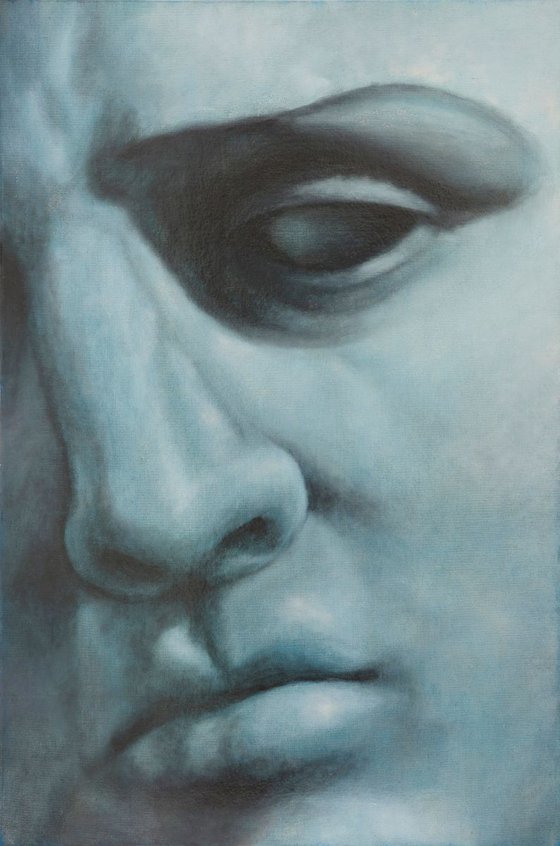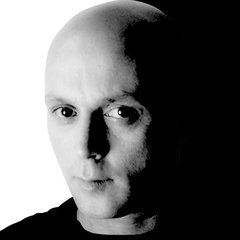- By medium
- By subject
- By budget
- Sales
- Gift cards
- Discover all art
- Artists
- Editors’ picks
- Ideas
Original artwork description:
Godhead (2016)
During the Hellenistic era and in early Rome, as well as portraits, sculptures were highly regarded. Besides artworks of Roman emperors and scientists, with an almost photographic realism and naturalism, also existed a typology of ideal sculptures which combined individual characteristics with more general ideas of beauty. Over time, different styles of portrait were developed. For example, from archaeological investigation we know of about one and a half dozen different types of portraits of Alexander the Great. The artist has used one of those categories as an initial incitation, here also showing a photographic reference to a Roman copy of an Alexander´s head, more precisely a type which is called “Akropolis-Erbach“. All the different styles were named by their place of finding or the place where they are kept.
This head is characterized by elegant curves, an aristocratic touch, soft eyes and eyebrows, an almost childlike nose, as well as sensual lips and chin. Above all, the brilliance and moisture of his huge eyes is normally understood as a reference to his enthusiastic and emotional temperament. These kinds of emperor sculptures are so charismatic that they look like images of young Gods and mythical heroes. It is still undecided if the emperors imitate the gods or if the gods imitate the emperors. The original sculptures were probably created by the Greek sculptors, Lysippos or Leokares.
Marcus Sprigens has painted this picture, Godhead (2016) in a classical artisan style called “Grisaille”, which means to paint strictly in darker and lighter tones of the first mid tone glaze, usually umbers and warm tones, in this instance blue has been used. Different layers of colours and translucent “scumble” are also applied. Here, the calm shadows of colours in pale blue intensify the impression of a lively bust made of stone. Additionally, the artist has changed the classical character of his incitation with an almost photographic crop. Due to this extract concentration, there is no crown or special head dress, nor distinguished precious clothing. Nor the whirl of hair situated on the forehead, which when used in that way is emblematic of announcing and symbolizing the bravery of a lion., where the hair acts as a lion's mane. In the context of scientific research this kind of hair is named anastolé (which means “to throw up” or “to throw upon”).
In this picture only the displayed sections of the physiognomy make for the positive identification of emotions: the eye and the brow, the nose, mouth and chin: a very limited repertoire of indices indeed to document the divineness of the god/king shown. Therefore, the painting seems archaic and modern at the same time. In between this strategy, which acts like a torso, Sprigens nevertheless has shown the mentioned details as heroic items. The brow has more energy, the nose more maleness, the mouth more full, the eye has more volume and glaze. Doing so the artist changes a boy to a man who is on the edge of his power, force and development. These details and the sharpened shadows also show the protagonist as a man experienced in pain. So the artist mixes antique iconographic formulas with Christian, even eschatological motifs. In this respect his god also shows and evokes sympathy.
This head also has the character of a celebrity from the public domain, who the paparazzi has snapshot without authorisation: an actor, a pop singer, a politician. On the zoomed surface of this neck lined face one may induce or decipher, already well known personages. In this respect, this head looks in all its strangeness familiar, but also in all its familiarity foreign. Striking and weathered at the same time: Elvis Presley, John Wayne and the Marlboro man, Sean Connery and Curd Jürgens, Jean Paul Belmondo and Lino Ventura or the face of the famous barkeeper Charles Schumann from Munich, but also martial warheads by Josef Thorak and Arno Breker. So the face of the god also acts as a kind of morphing of different physiognomies: a mixture, a melange, even a logo for virility and masculinity.
Godhead (2016) of Marcus Sprigens, combines religious charisma and political power with cultural and scientific competence. A carefully meditating god is shown by the artist. Past and possibly future evils and nameless frights are reflected in his empty and anticipating gaze. There seems no way out, but to exist. So the artist shows us a powerful creature who by reflecting on himself is not able or willing to execute his power without care. So it is a god with no orientation who criticises his own criteria of decision making; a doubtful god for whom the doubt is essential. On the other hand we see both the sensibility and empathy of this god, who is more sympathetic than a pure macho emperor just executing his decisions without sensibility. So the message of this artwork is quite clear: emperors as well as powerful people in general and even gods should be aware and should take care of their power, working and dealing with it, with more hesitation and scrupulousness than boisterousness, brutishness and violence.
Text: Prof. Volker Fischer, Master Curator, Art Historian and Critic, Former Curator of the Museum of Artificial Art (MAK) Frankfurt, Former Director of the Museum of Architecture (DAM) Frankfurt, Honorary Professor of the Academy of Art and Design, Offenbach am Main/Frankfurt.
Materials used:
Oils
Tags:
#godhead #classical greek #classical roman #portrait #grisaille #hellenisticGodhead (2016) Oil painting
by Marcus Sprigens
1 Artist Reviews
£1,850 Sold
- Oil painting on Canvas
- One of a kind artwork
- Size: 50.01 x 75.01 x 0.41cm (unframed) / 50.01 x 75.01cm (actual image size)
- Signed on the back
- Style: Photorealistic
- Subject: People and portraits
Do you like this artwork?
This artwork has sold, but the artist is accepting commission requests. Commissioning an artwork is easy and you get a perfectly personalised piece.
Loading
Original artwork description
Godhead (2016)
During the Hellenistic era and in early Rome, as well as portraits, sculptures were highly regarded. Besides artworks of Roman emperors and scientists, with an almost photographic realism and naturalism, also existed a typology of ideal sculptures which combined individual characteristics with more general ideas of beauty. Over time, different styles of portrait were developed. For example, from archaeological investigation we know of about one and a half dozen different types of portraits of Alexander the Great. The artist has used one of those categories as an initial incitation, here also showing a photographic reference to a Roman copy of an Alexander´s head, more precisely a type which is called “Akropolis-Erbach“. All the different styles were named by their place of finding or the place where they are kept.
This head is characterized by elegant curves, an aristocratic touch, soft eyes and eyebrows, an almost childlike nose, as well as sensual lips and chin. Above all, the brilliance and moisture of his huge eyes is normally understood as a reference to his enthusiastic and emotional temperament. These kinds of emperor sculptures are so charismatic that they look like images of young Gods and mythical heroes. It is still undecided if the emperors imitate the gods or if the gods imitate the emperors. The original sculptures were probably created by the Greek sculptors, Lysippos or Leokares.
Marcus Sprigens has painted this picture, Godhead (2016) in a classical artisan style called “Grisaille”, which means to paint strictly in darker and lighter tones of the first mid tone glaze, usually umbers and warm tones, in this instance blue has been used. Different layers of colours and translucent “scumble” are also applied. Here, the calm shadows of colours in pale blue intensify the impression of a lively bust made of stone. Additionally, the artist has changed the classical character of his incitation with an almost photographic crop. Due to this extract concentration, there is no crown or special head dress, nor distinguished precious clothing. Nor the whirl of hair situated on the forehead, which when used in that way is emblematic of announcing and symbolizing the bravery of a lion., where the hair acts as a lion's mane. In the context of scientific research this kind of hair is named anastolé (which means “to throw up” or “to throw upon”).
In this picture only the displayed sections of the physiognomy make for the positive identification of emotions: the eye and the brow, the nose, mouth and chin: a very limited repertoire of indices indeed to document the divineness of the god/king shown. Therefore, the painting seems archaic and modern at the same time. In between this strategy, which acts like a torso, Sprigens nevertheless has shown the mentioned details as heroic items. The brow has more energy, the nose more maleness, the mouth more full, the eye has more volume and glaze. Doing so the artist changes a boy to a man who is on the edge of his power, force and development. These details and the sharpened shadows also show the protagonist as a man experienced in pain. So the artist mixes antique iconographic formulas with Christian, even eschatological motifs. In this respect his god also shows and evokes sympathy.
This head also has the character of a celebrity from the public domain, who the paparazzi has snapshot without authorisation: an actor, a pop singer, a politician. On the zoomed surface of this neck lined face one may induce or decipher, already well known personages. In this respect, this head looks in all its strangeness familiar, but also in all its familiarity foreign. Striking and weathered at the same time: Elvis Presley, John Wayne and the Marlboro man, Sean Connery and Curd Jürgens, Jean Paul Belmondo and Lino Ventura or the face of the famous barkeeper Charles Schumann from Munich, but also martial warheads by Josef Thorak and Arno Breker. So the face of the god also acts as a kind of morphing of different physiognomies: a mixture, a melange, even a logo for virility and masculinity.
Godhead (2016) of Marcus Sprigens, combines religious charisma and political power with cultural and scientific competence. A carefully meditating god is shown by the artist. Past and possibly future evils and nameless frights are reflected in his empty and anticipating gaze. There seems no way out, but to exist. So the artist shows us a powerful creature who by reflecting on himself is not able or willing to execute his power without care. So it is a god with no orientation who criticises his own criteria of decision making; a doubtful god for whom the doubt is essential. On the other hand we see both the sensibility and empathy of this god, who is more sympathetic than a pure macho emperor just executing his decisions without sensibility. So the message of this artwork is quite clear: emperors as well as powerful people in general and even gods should be aware and should take care of their power, working and dealing with it, with more hesitation and scrupulousness than boisterousness, brutishness and violence.
Text: Prof. Volker Fischer, Master Curator, Art Historian and Critic, Former Curator of the Museum of Artificial Art (MAK) Frankfurt, Former Director of the Museum of Architecture (DAM) Frankfurt, Honorary Professor of the Academy of Art and Design, Offenbach am Main/Frankfurt.
Materials used:
Oils
Tags:
#godhead #classical greek #classical roman #portrait #grisaille #hellenistic14 day money back guaranteeLearn more


